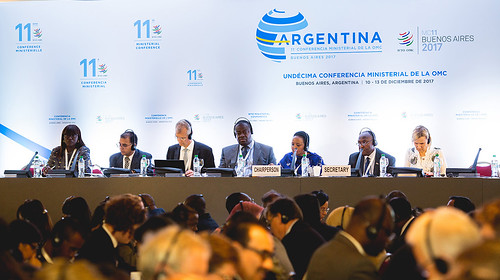
Following the conclusion of the 11th World Trade Organization (WTO) Ministerial Conference last month, it’s time for WTO members to reflect, reset, and reinvigorate the agriculture negotiations to tackle the real-world international trade concerns that face agriculture today.
At the Buenos Aires ministerial, commonly called “MC11,” trade ministers and other high-level representatives from 164 WTO member economies were unable to reach consensus on any new agricultural provisions or post-MC11 work plans. This simply underscores the fact that WTO members’ current negotiating strategies are not working. We need a new approach that involves the development of a more market-oriented agricultural trading system. Such an approach would be in line with the core objective of the WTO Agreement on Agriculture: establishing fundamental reforms to achieve substantial, progressive reductions in support and protection. The United States remains fully committed to this objective.
I’ve been involved in multilateral trade negotiations for almost 30 years, and it was my honor to be the U.S. Department of Agriculture’s (USDA) senior official in the U.S. delegation to MC11. The 1995 WTO Agreement on Agriculture was truly a breakthrough, establishing for the first time disciplines on countries’ use of measures, such as import quotas and subsidies, that might impede the free flow of trade. But we must recognize the global agricultural trading environment has changed significantly since the first major negotiations to update these rules were undertaken in the Doha Round in 2001. Today, agricultural trade is no longer dominated by a few large developed countries. We’re seeing the increased role of South-South trade, as well as the emergence of several large developing countries both in terms of their role in agricultural production and trade, and their expenditures on trade-distorting agricultural policies.
While the Doha Round began with efforts to achieve significant trade liberalizing reforms, that ambition has slowly declined over the nearly two decades that have passed. It has become evident in recent years, and was underscored again last month in Buenos Aires, that some WTO members are more interested in increasing trade barriers than in eliminating them. The WTO needs to refocus on its core functions of opening markets and promoting trade through comprehensive negotiations of both domestic support and market access, as well as any other identified trade barriers.
Before embarking on further agricultural negotiations, the United States has called on WTO members to implement the existing WTO agreements and decisions they have already agreed to. In this regard, a crucial first step is for members to meet their transparency obligations, which many are years behind on. In the absence of transparency, how are we to determine whether members are complying with existing obligations? Moreover, only with comprehensive and current information can negotiators understand, discuss, and address the problems that face farmers today: high tariffs, trade distorting support, and non-tariff barriers.
On the subject of non-tariff barriers, I’d like to highlight the efforts of the United States, Kenya, and Uganda that resulted in a joint statement on pesticide maximum residue levels (MRLs), which was signed by 17 countries at MC11. The statement reinforces the critical role of science-based standards under existing WTO rules and recognizes the increase in MRL and similar regulatory issues faced by farmers around the world. We look forward to further work with other WTO members to ensure trade is not hampered by non-scientific regulatory barriers.
With MC11 behind us, here at USDA we’ll continue to develop analysis and strategies to improve the agricultural trading system and ensure that we, as a global community, are able to feed a rapidly growing world. Improving production and market efficiencies through evidence-based government policies will be critical to that effort. As I’ve said before, America’s agricultural producers and ranchers wouldn’t be where they are today without global markets – and the multilateral trading system – but the benefits of agricultural trade reach far beyond our farms, ranches and rural communities.
